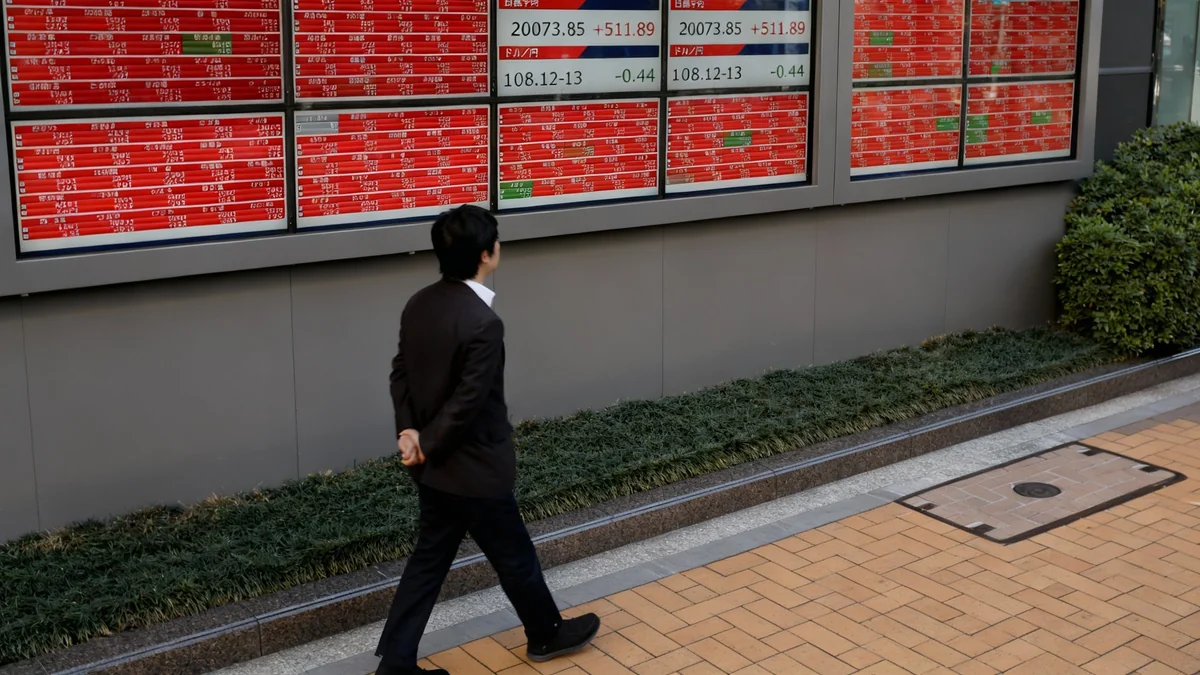Asian stock markets opened the week with strong gains, driven by a temporary trade truce between the United States and China and continued investor enthusiasm for artificial intelligence. The positive sentiment pushed the region's key index near a 4.5-year high, reflecting a broader market rally that has seen significant growth throughout the year.
However, the optimism is being met with caution as hawkish comments from some U.S. Federal Reserve officials have strengthened the dollar to a three-month high. This has led investors to reconsider the likelihood of future interest rate cuts, introducing a layer of uncertainty into the global economic outlook.
Key Takeaways
- Asian stocks, led by MSCI's Asia-Pacific index, climbed on Monday, continuing a strong yearly performance.
- A U.S.-China trade truce and sustained investment in AI are the primary drivers of the current market optimism.
- The U.S. dollar has reached a three-month high following comments from Federal Reserve officials suggesting a pause in rate cuts.
- Investors are now focused on upcoming earnings reports from major tech companies to gauge the real-world returns on AI investments.
Market Rally Gains Momentum Across Asia
Investor confidence was evident across major Asian markets. MSCI's broadest index of Asia-Pacific shares outside Japan saw an increase of 0.63%, bringing it to 729.82. This positions the index near its highest level since early 2021 and marks a year-to-date gain of over 27%, putting it on track for its best annual performance since 2017.
Individual markets also posted impressive results. South Korea's KOSPI index surged by more than 2% to reach a new record high. In China, the blue-chip CSI300 index was up 0.1%, while Hong Kong's Hang Seng Index rose by 1%. Trading was muted in Japan as markets were closed for a public holiday.
The U.S.-China Trade Truce
The recent agreement between the U.S. and China to pause new tariffs for one year has provided temporary relief to global markets. While the truce was largely expected, it has removed immediate uncertainty, allowing investors to focus on other economic drivers. However, questions remain about the long-term stability of the agreement.
Despite the positive market movements, some analysts are advising a cautious approach. Strategists at BofA suggested that much of the optimism from the trade truce has already been factored into current stock prices. They recommended that investors consider securing some profits and shifting toward more defensive positions as the year comes to an end.
Federal Reserve Signals Caution
While markets celebrate the trade developments, attention is shifting to monetary policy in the United States. Recent statements from several Federal Reserve bank presidents have indicated a reluctance to continue cutting interest rates. This sentiment follows the central bank's decision last week to lower rates by 25 basis points, a move that was widely anticipated.
Fed Chair Jerome Powell noted that another rate cut at the December meeting was "not a foregone conclusion." This has caused a significant shift in market expectations.
Shifting Rate Cut Odds
Before the latest Fed meeting, investors saw a December rate cut as nearly certain. Now, traders are pricing in only a 68% chance of such a move, indicating a substantial recalculation of the Fed's likely path forward.
This more hawkish stance from some policymakers contrasts with calls for further easing from others, such as Fed Governor Christopher Waller, who argued for more stimulus to support a weakening labor market. This division within the central bank is creating a complex picture for investors trying to predict future policy.
Dollar Strengthens on Rate Cut Doubts
The changing expectations around Fed policy have had a direct impact on currency markets. The U.S. dollar has strengthened significantly as the prospect of further rate cuts diminishes. The euro fell to a three-month low, trading at $1.1524.
Other major currencies also felt the pressure. The British pound sterling eased 0.2% to $1.3142, while the Japanese yen weakened to 154.05 per U.S. dollar, near its lowest point since mid-February. Analysts at Goldman Sachs noted that while the U.S. economy may not outperform other economies as it has in the past, the dollar's current strength reflects the immediate uncertainty.
"We continue to think that the motivation for the rate cuts is consistent with our premise for further dollar downside... That will lead to a weaker dollar over time given its strong starting point," Goldman Sachs strategists wrote in a note to clients.
Compounding the economic uncertainty is the ongoing U.S. government shutdown, which began on October 1. The shutdown, now the second-longest in U.S. history, is delaying the release of key economic data, including job openings and non-farm payrolls. Investors will instead be watching a private employment report from ADP later this week for insights into the labor market.
AI and Earnings in the Spotlight
The global stock market rally this year has been heavily fueled by excitement surrounding artificial intelligence. Now, investors are looking for tangible proof that the massive capital expenditures in AI infrastructure are translating into profits.
The upcoming earnings season will be a critical test. After mixed results from some megacap companies, the focus now shifts to a new wave of tech firms. Key reports to watch this week include:
- Advanced Micro Devices (AMD)
- Qualcomm
- Palantir Technologies
These semiconductor and data analytics companies are at the heart of the AI revolution, and their financial results will be scrutinized for signs of sustainable growth. Other major companies reporting this week, such as McDonald's and Uber, will also provide insights into consumer spending and the broader economic health.
In the commodities market, gold has stabilized above $4,000 per ounce as some investors seek safe-haven assets. Meanwhile, oil prices have edged higher after OPEC+ decided to maintain current production levels for the first quarter of next year. Brent crude futures rose 0.32% to $64.98 a barrel, and U.S. West Texas Intermediate crude was up 0.28% at $61.16 a barrel.





